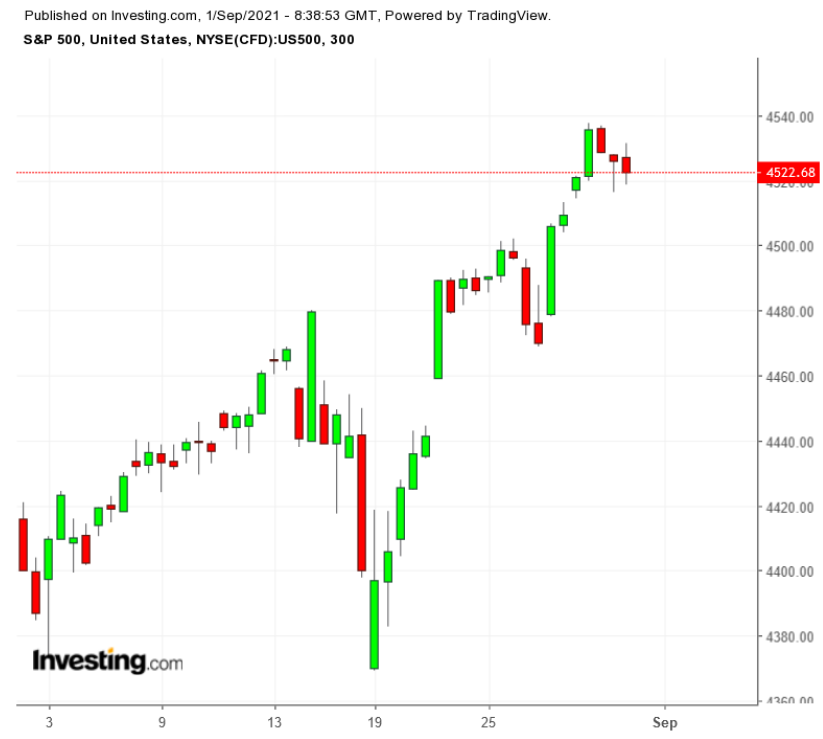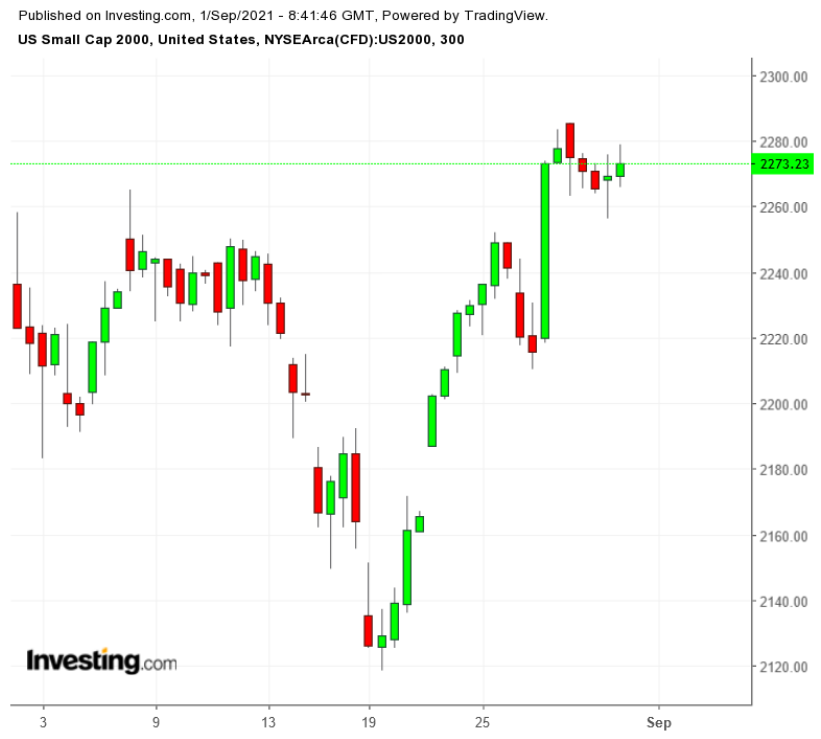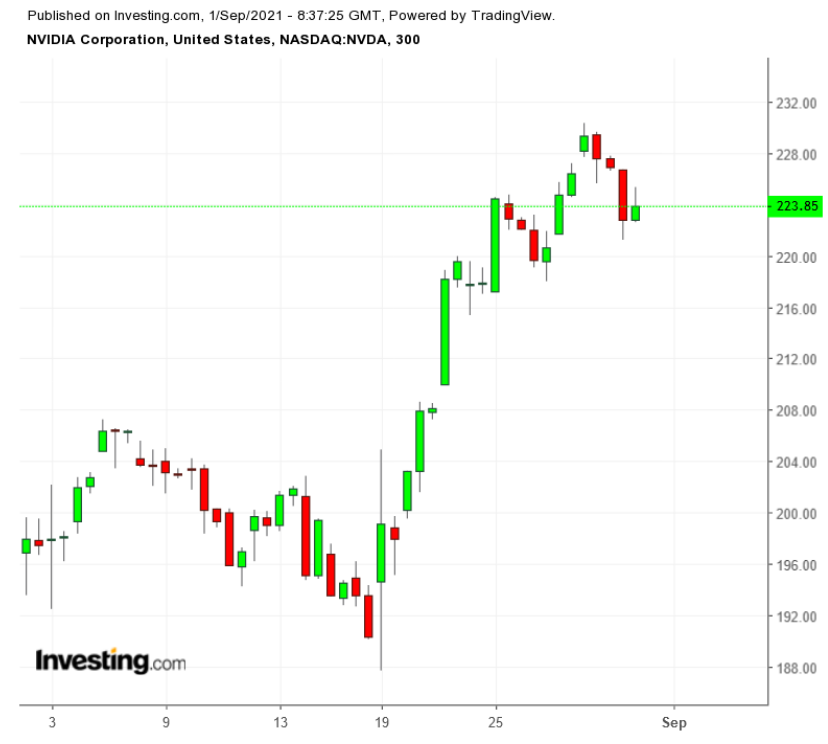Stocks ended August solidly—if not spectacularly—higher despite hugely negative headlines.
These, of course, included the United States withdrawal from Afghanistan, global worries about the spread of the Delta variant of COVID-19, and a major hurricane battering New Orleans and southeast Louisiana.
If you're ahead on the month, thank Federal Reserve Chairman Jerome Powell. Last week, he said the central bank will start to wind down its stimulus efforts—but slowly. The odds, in fact, are there won't be an interest rate hike in the United States until perhaps late in 2022 or early 2023.
As a result, the S&P 500 Index finished the month up 2.9% and is up 20.4% on the year.

The index's seven-month winning streak is the longest since a 10-month stretch between April 2017 and January 2018.
The broad benchmark has closed at a new high on 53 days this year, the fourth-best showing ever, according to Standard & Poor's, and there are still four months left in the year.
Meanwhile, the NASDAQ Composite climbed 4% during August, its third-best monthly gain this year. The NASDAQ 100 Index rose 4.2% during the same period. The tech-heavy indices are up 18.4% and 20.9%, respectively thus far for 2021.
The Dow Jones Industrial Average turned in a 1.2% gain for the month, modest to be sure, but the blue chip index is up 15.3% for the year.
Geopolitical Stresses, Shifting Internal Reality For Stocks
Still, there are concerns to keep in mind:
- Fears that inflationary forces unleashed when the economic recovery began last year can't be contained.
- The Delta variant of the COVID virus could prove more virulent than the version that spread across the country in 2020, forcing another economic shutdown. (To underscore the point, the Seattle Children's Hospital said Tuesday one of its patients died of the virus a week ago.)
- Geopolitical stresses, particularly in Afghanistan and East Asia.
After that, consider this internal reality for equities:
The overall market gains have recently reflected gains among the biggest and fastest-growing stocks. Gains for mid-cap and small-cap stocks have moderated since a robust rally in the first quarter.
The Russell 2000 index last set a 52-week high and closing high on Mar. 15.

It was up 12.4% in the first quarter. The mid-cap S&P 400 rose 13.1% in the first quarter and peaked on May 10. The small-cap S&P 600 Index was up 18% in the first quarter and peaked on June 8.
Markets were assisted by a number of helpful catalysts: the Fed's ongoing low interest rate policy, moderating oil prices (crude fell roughly 10%), and gains in consumer spending were set off by a hoped-for end to the COVID-19 virus. Home buying in the United States is robust, if buyers can actually find one, and prices are rising—a boon for sellers.
Corporate earnings have generally been very strong over the last nine months, especially for tech stocks. The top 10 stocks in the S&P 500 represent 28% of the market cap of the index. Six are tech stocks.
In theory, the decent condition of the economy now could set financial markets up for continued gains at least through the end of the year. Stocks generally have benefitted from ultra-low rates.
Economic Blips, Seasonality Remain A Factor
But blips will show up. Zoom Video Communications (NASDAQ:ZM) fell 16.7% to $289.50 on Tuesday, after forecasting growth will decelerate in coming quarters.
Stocks may take a hit if Friday's nonfarm payrolls report underwhelm. Investing.com is estimating jobs created in August to rise by 750,000, with the unemployment rate dipping to 5.2% from last month's 5.4%. A year ago, the unemployment rate hit as high as 14.5%.
The Fed wants to see the payroll number go up and the unemployment rate continue to fall, even as critics on Wall Street and elsewhere worry that inflation, triggered when the recovery began in 2020, could prove more difficult than anyone expects.
Fed officials have mostly pushed back against the worries, arguing the recovery is too fragile to start raising rates too early.
And many investors are comfortable with the Fed. Powell's speech on Friday was warmly received by markets. The S&P 500, NASDAQ and NASDAQ 100 all closed at new highs.
The S&P 500 has hit a new closing high at least once a week since the week of June of 7. The NASDAQ 100 has had 20 closing highs since early June and 18 52-week highs since early June as well.
History suggests that the more the stock market depends on returns from fewer and fewer companies, the more likely it becomes more vulnerable to a pullback.
September can be wildly volatile. In September 2008, the S&P 500 fell 9.1% as the Great Recession erupted. The major indices sagged during the same month in 2011 and 2015 and slipped mildly in 2020.
August's Winners And Losers
The stars of August (at least in the S&P 500) were
- Financial stocks, including Goldman Sachs (NYSE:GS), up 10.3% in August, tops among the 30-component Dow as well.
- Communications stocks, including Facebook (NASDAQ:FB), Alphabet (NASDAQ:GOOGL), Netflix (NASDAQ:NFLX) and Walt Disney (NYSE:DIS).
- Technology stocks including Apple (NASDAQ:AAPL), Microsoft (NASDAQ:MSFT) and chip-maker NVIDIA (NASDAQ:NVDA), an important force in graphics computing and crypto-current processing. Apple, Microsoft, Amazon (NASDAQ:AMZN), Alphabet and Facebook now have market capitalizations topping $1 trillion.

- NVIDIA shares are up 15% for the month and about 70% this year.
- Utilities stocks, prized for their dividends and stable earnings as defensive shares took center stage.
The losing sectors:
- Materials, including mining stocks, for example Newmont Mining (NYSE:NEM) and FMC (NYSE:FMC).
- Consumer Discretionary, including Starbucks (NASDAQ:SBUX) and Target (NYSE:TGT).
- Industrials, including General Motors (NYSE:GM) and Boeing (NYSE:BA).
- Consumer staples, including Clorox (NYSE:CLX) and McDonald's (NYSE:MCD).
- Energy, including Halliburton (NYSE:HAL) and Chevron (NYSE:CVX).
Among non-equity assets there was one big winner: Bitcoin, up 13.2% on the month, closing at the end of August at $46,996. But what a ride. It peaked in mid-April at $64,788, fell nearly 54% to $29,366 on July 20. Then cryptocurrency rebounded as much as 72% to nearly $51,000 before falling back.
Perhaps the month's biggest loser however wasn't a stock at all but rather Lumber. The commodity shot up $1,733.50 per 1,000 board-feet in May and collapsed thereafter, finishing August at $482.80, off 72%.
